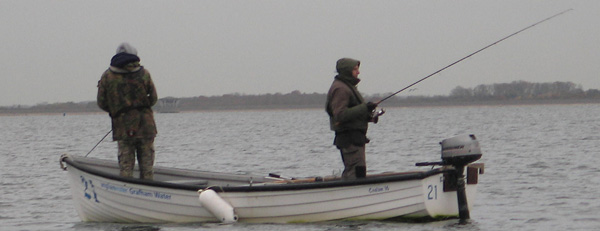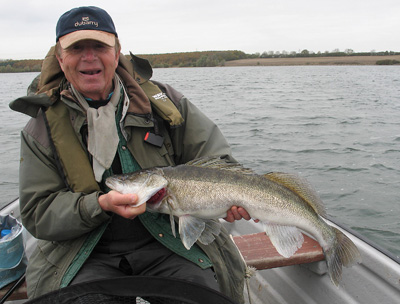Looking back over the last month, the main event I need to cover is a day spent on Grafham Water with my good friend and fellow Northampton Specimen Group (NSG) member Bob Church in search of a big zander.
I’d fished Grafham for the zander with Bob on two separate occasions a few years back, and we’d caught a couple of nice fish. However I’d not been totally happy that, despite being unhooked and returned quickly, and swimming off strongly, the fish that we were catching – from relatively deep water – had survived the experience. My concern was centered around the slightly unsettling gaping mouth that nearly all of the zander caught appeared to display and the fact that the returns, especially for the larger specimens, appeared to be diminishing rapidly.
I discussed my concerns about the wellbeing of the zander a few times with Bob and fellow NSG member Mike Green, without being able to reach any firm conclusions, but my initial concerns were enough to stop me making further return visits. A while back the subject came up again after Bob shared with me a number of photos of a very fit and healthy looking double figure zander that he’d recently caught from Grafham. It seemed that for some mysterious reason the instance of the gaping mouths on the zander being caught were becoming rarer and that there were still some very big zander being caught for those fishing the right baits and methods in the right areas.
Bob and Mike had helped to highlight the zander potential of Grafham (and to an extent Rutland Water) and to popularize the zander fishing on these huge reservoirs with their innovative fly fishing techniques geared towards catching these at times enigmatic predators and the subsequent publicity that their excellent results received. As time has gone on the fish have no doubt wised up to certain presentations and baits and techniques have had to change and evolve to help ensure that a few fish are still being caught. The situation nowadays is that there is quite a variety in the different methods used to target the zander on this huge reservoir.
It was beginning to look as though the time was right to make a return trip to find out for myself what the fishing was like so, after a quick check of respective diaries, and a study of the long-range weather forecast I arranged a trip with Bob as my boat partner.
Bob is in his late 70’s and suffers from Parkinson’s, so isn’t as agile and dexterous as he once was and I suffer quite badly with extensive arthritis, which can vary quite a bit in terms of its day-to-day impact, so we’re perhaps not the most suitable pair of anglers to be sharing a boat and zipping about all over the place on a big water like Grafham. However on the day in question we soon had a plan of action worked out and decided that spending most of the day in a known hotspot with each of us putting a couple of deadbaits out was likely to be our best approach.

Bob had been keeping up to date with the most productive baits and methods and had given me a few pointers prior to the trip. He’d recommended small mackerel sections as the best bait, though when I saw the baits that he was intending on using I had my reservations as he reckoned that baits that weren’t necessarily all that fresh and had been in and out of the freezer a few times were the best bet. Bob generously offered to share some of his bait with me, but I turned my nose up at his ‘smelly little mackerel tails’ and fished with a large fresh half mackerel on one rod, whilst swapping about with smelt, sardine etc. on the other rod.
Bob elected to fish both of his baits with straightforward running ledger rigs incorporating quite light leads, with the braided mainline and rod tip movement as bite indicators. I fished my two rods in a similar fashion, but used monofilament mainlines and heavier leads and incorporated inline floats set at a fraction over depth as an indication of any interest in the baits.
It had been quite some time since I’d last been afloat on one of the big reservoirs, but with some guidance from Bob I managed to muddle my way through and after spending some time carefully locating and ensuring we were correctly positioned and anchored up over a good spot we were ready to get the baits out.
The morning period was inactive in terms of the fishing results, but time sped by as we caught up on each other’s news and swapped our latest stories. The first action of the trip initially appeared to be on my rod as my float slowly sank from sight. However it was soon apparent that it was in fact a run on one of Bob’s baits, with the fish going through my line as it moved away.
 Bob was soon on the case and before too long I was netting a nice zander of about 8lb for him, clearly those ‘smelly little mackerel tails’ weren’t quite as duff as I’d first thought… It was good to see that the fish looked really healthy and none the worse for having being caught and after a couple of quick photos it was back in the water and powering off back to the depths.
Bob was soon on the case and before too long I was netting a nice zander of about 8lb for him, clearly those ‘smelly little mackerel tails’ weren’t quite as duff as I’d first thought… It was good to see that the fish looked really healthy and none the worse for having being caught and after a couple of quick photos it was back in the water and powering off back to the depths.
It was about an hour before the next bite and this time the indication of a run on my sardine-baited rod turned out to be the real thing. It didn’t feel like anything huge and with the hooked fish darting around a little bit too quickly to be a zander it wasn’t long before our suspicions were confirmed as a decent brownie just shy of 5lb came to the boat.
Despite the chilly conditions, and the fact that we were fishing midweek, Bob and I weren’t the only guys out on the water having a go for the predators; which just goes to prove the popularity of the pike and zander fishing on some of the Anglian Water controlled reservoirs. It must provide some very welcome extra profits for AW, as does the pike fishing on some of the other trout waters across the country controlled by the various water companies. It will be interesting to see if there’ll be further developments on these waters as the different companies contemplate the extra revenue that opening up the fishing even further and allowing keen coarse anglers the opportunity to target some of the vast stocks of other coarse fish stocks that these waters contain.
I can’t help wondering what the bream fishing potential on Grafham might be like if I was allowed to fish the right areas using the right tackle and bait, and the eel fishing potential on Rutland Water, based on a handful of eels caught by accident by trout fishermen or netted, looks as though it could be phenomenal.
Similarly some of the more adventurous carp anglers must be dreaming about some of the uncaught monsters that could be lurking about in some of the big reservoirs. In fact the list just goes on and on, with the numerous possibilities a very exciting proposition for the future if the fishing could be organized and managed correctly.
As the afternoon wore on we were confident of some more action, but unfortunately it wasn’t to be and we eventually had to up anchor and head back to the lodge. We were happy with our result though and I had to conclude that zander fishing on Grafham was something that could go back onto my list of things to be tried again whenever a suitable opportunity came up.
Late in December I also managed to squeeze in another trip back to the river in search of a 1lb plus dace. I managed some good-sized dace amongst a nice mixed bag of different species, so often the case when trotting maggot and/or caster on this particular section of river. While a handful of the dace were around the 8oz mark there was nothing that looked to be worth getting the scales out for, but the numbers and quality of all the different species was really pleasing.
While they can prove something of a nuisance, especially in the warmer months, it was good to note the healthy sizes of some of the mini species that I was catching along with everything else. Quality gudgeon and minnows are a good indicator of a healthy river, so some fat examples of each helped to put a smile on my face. I wish gudgeon grew to ‘proper’ sizes, as I reckon, pound for pound, they could pull even harder than barbel!

By the time this particular piece actually appears on the site, a charity event that I’m doing a talk/slide presentation for won’t be too far away. The event itself is staged by the King’s Arms Angling Club (KAAC) and is all about raising funds for the Sue Ryder Care charity. It’s become an annual event, getting more and more popular each year.
The chief organizer is Graham Inwood, with assistance from Bob Church and Mike Green. The actual date of the charity evening is Monday 24 February and it’s being held at the Holiday Inn Garden Court at Sandy (Bedfordshire). Both Stuart Gillham (of 40lb carp and pike and Gillhams Fishing Resorts (Thailand) fame) and I have volunteered to do a presentation as part of the evening’s entertainment.
There are also fantastic prizes in the special auction and raffle and plenty of other things going on, so it promises to be an interesting event. Attendance for the event is via ticket only, with tickets from Graham on 01767 223657.
As I’ve been writing this, large areas of the country have been suffering some rather large scale floods and my local rivers have at times been well over the top of the banks in some of the more susceptible areas. With plenty more wet weather being forecast it could make things a bit touch and go for some of the river fishing that I’d hoped to be doing in the early part of the year.
Whatever I end up doing I’ll be sharing the news with you next time.
Until then… happy fishing!










